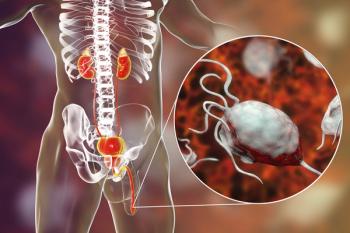
Prostate-Specific Membrane Antigen PET/CT Suitable Imaging for Prostate Cancer
Prostate-specific membrane antigen PET/CT was found to be a suitable replacement for conventional imaging in patients with prostate cancer, providing superior accuracy to the combined findings of CT and bone scanning.
A study published, in The Lancet, found that prostate-specific membrane antigen (PSMA) PET/CT is a suitable replacement for conventional imaging in patients with prostate cancer that provides superior accuracy to the combined findings of CT and bone scanning.1
Though the study did not assess whether the scans had any effect on patient survival, the researchers suggest that this approach could improve outcomes by helping doctors decide whether to offer a localized treatment, such as surgery or radiotherapy, or to use more advanced treatments to treat the whole body if the cancer has already spread.
“Taken together, our findings indicate that PSMA PET/CT scans offer greater accuracy than conventional imaging and can better inform treatment decisions,” study lead Michael Hofman, of the Peter MacCallum Cancer Center in Australia, said in a press release.2 “We recommend that clinical guidelines should be updated to include PSMA PET/CT as part of the diagnostic pathway for men with high risk prostate cancer.”
In this multicenter, randomized study cohort of 302 men recruited with biopsy-proven prostate cancer and high-risk features from 10 hospitals in Australia, researchers randomly assigned 152 men to conventional imaging with CT and bone scanning and 150 to gallium-68 PSMA-11 PET/CT. First-line imaging was performed within 21 days following randomization, and patients crossed over unless 3 or more distant metastases were identified. Of 295 (98%) men with follow-up, 87 (30%) had pelvic nodal or distant metastatic disease.
The primary outcome for the study was accuracy of first-line imaging for identifying either pelvic nodal or distant metastatic disease, defined by the receiver operating curve using a predefined reference standard including histopathology, imaging, and biochemistry at 6-month follow-up.
PSMA PET/CT was found to have a 27% (95% CI, 23%-31%) greater accuracy than that of conventional imaging (92% [range, 88%-95%] vs 65% [range, 60%-69%]; P < 0.0001). Moreover, the researchers found a lower sensitivity (38% [range, 24%-52%] vs 85% [range, 74%-96%]) and specificity (91% [range, 85%-97%] vs 98% [range, 95%-100%]) for conventional imaging compared with PSMA PET/CT. Subgroup analyses also showed the superiority of PSMA PET-CT (area under the curve of the receiver operating characteristic curve 91% vs 59% [32% absolute difference; range, 28-35] for patients with pelvic nodal metastases, and 95% vs 74% [22% absolute difference; range, 18-26] for patients with distant metastases).
Furthermore, first-line conventional imaging reported management change less frequently (23 [15%] men [range, 10-22] vs 41 [28%] men [range, 21-36]; P = 0.008) and had more equivocal findings (23% [range, 17-31] vs 7% [range, 4-13]) than PSMA PET-CT did. Radiation exposure was 10.9 mSv (95% CI, 9.8-12.0) higher for conventional imaging than for PSMA PET-CT (19.2 mSv vs 8.4 mSv; P < 0.001). The researchers also found high reporter agreement for PSMA PET-CT (κ = 0.87 for nodal and κ = 0.88 for distant metastases). In patients who underwent second-line image, management change occurred in 7 (5%) of 136 patients following conventional imaging, and in 39 (27%) of 146 following PSMA PET/CT.
"Around 1 in 3 prostate cancer patients will experience a disease relapse after surgery or radiotherapy,” senior author Declan Murphy, of the Peter MacCallum Cancer Center in Australia, said in a press release. “This is partly because current medical imaging techniques often fail to detect when the cancer has spread, which means some men are not given the additional treatments they need. Our findings suggest PSMA PET/CT could help identify these men sooner, so they get the most appropriate care."
Notably, some patients within the study had undergone further testing to confirm the spread of their disease, which included removing tissue from their pelvic lymph nodes. Researchers acknowledged this as the most reliable test for assessing the stage of prostate cancer disease spread. However, they also caution that as not all patients underwent the procedure, it could have led to an overestimation in the sensitivity of PSMA PET/CT.
The authors suggested that costs associated with the approach studied vary in different regions of the world, however it could offer saving over conventional imaging techniques. A full health-economic analysis should help to determine the cost-effectiveness though, both from a patient and healthcare perspective.
In an editorial commentary, Caroline Moore, of the University College London, indicated that such evaluations though are already underway.3
“Introduction of novel imaging into routine practice requires careful assessment of the potential burden to both individuals and to society, taking into account changes in treatment which can result,” Moore wrote. “The proPSMA authors have planned an economic analysis of the potential effect of replacing conventional staging with PSMA-PET, which will be crucial in assessing the feasibility of widespread use of PSMA PET-CT in men being considered for radical treatment for high-risk prostate cancer.”
References:
1. Hofman MS, Lawrentschuk N, Francis RJ, et al. Prostate-specific membrane antigen PET-CT in patients with high-risk prostate cancer before curative-intent surgery or radiotherapy (proPSMA): a prospective, randomized, multi-center study. The Lancet. doi:10.1016/S0140-6736(20)30314-7.
2. The Lancet: Prostate cancer study finds molecular imaging could transform management of patients with aggressive cancer [news release]. Published March 22, 2020. eurekalert.org/pub_releases/2020-03/tl-pss031820.php. Accessed March 26, 2020.
3. Moore C. Prostate-specific membrane antigen PET-CT before radical treatment. The Lancet. doi:10.1016/S0140-6736(20)30527-4.
Newsletter
Stay up to date on recent advances in the multidisciplinary approach to cancer.

















































































